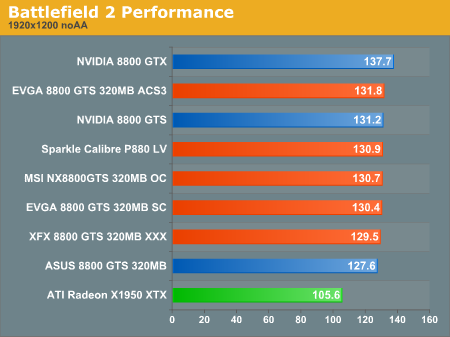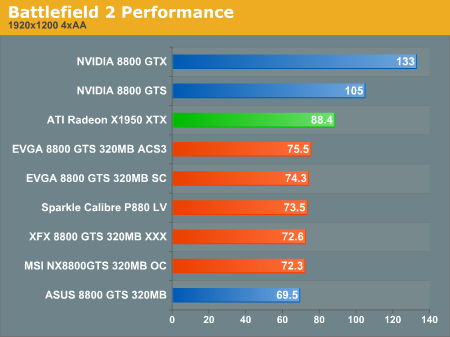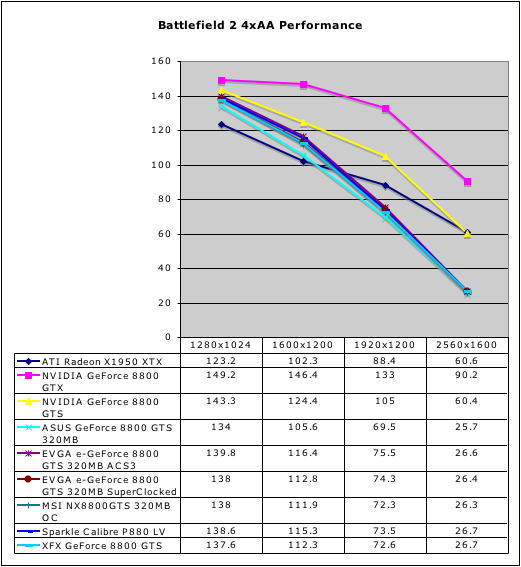Battlefield 2 Performance
It is worth mentioning again that gameplay on BF2 is locked to 100fps, so any higher result is only going to net you at maximum 100 fps. Of course, with averages higher than 100, the framerate is also dropping below 100 fps less frequently meaning that high framerates aren't totally useless. If you can stay above 60 FPS minimum frame rates and you have an LCD, you might also just turn on VSYNC to improve the overall image quality by avoiding sheering.


Without AA, the 320MB 8800 cards are able to significantly lead the X1950 XTX in performance. Even up to 2560x1600 without AA, all of our tests show huge framerates with very little variance between our overclocked hardware. The stock clocked ASUS card does lag the rest of the pack, but the performance difference under BF2 without AA would not be noticeable.


With AA enabled, the lower memory GTS takes a very significant performance hit, especially at 2560x1600. There still isn't much differentiation between the cards here either. It is important to note that the AMD X1950 XTX does perform much better than all the 8800 GTS 320MB hardware we tested when 4xAA is enabled under BF2. While the 8800 GTS 320MB cards are all able to handle resolutions up to 1920x1200, the AMD X1950 XTX is able to play the game very well at 30" panel resolutions.
This is also the only test we will see today where the 320MB hardware performs significantly worse than the 640MB version of the GTS. While many of our tests do show the 640MB and 320MB hardware producing similar results, it is worth noting that there are cases where memory size will have a major impact on performance. Whether this will be more or less of a factor in the future is not certain, but people with huge resolution displays who want to enable AA would probably be better off with the higher memory part.
It is worth mentioning again that gameplay on BF2 is locked to 100fps, so any higher result is only going to net you at maximum 100 fps. Of course, with averages higher than 100, the framerate is also dropping below 100 fps less frequently meaning that high framerates aren't totally useless. If you can stay above 60 FPS minimum frame rates and you have an LCD, you might also just turn on VSYNC to improve the overall image quality by avoiding sheering.


Without AA, the 320MB 8800 cards are able to significantly lead the X1950 XTX in performance. Even up to 2560x1600 without AA, all of our tests show huge framerates with very little variance between our overclocked hardware. The stock clocked ASUS card does lag the rest of the pack, but the performance difference under BF2 without AA would not be noticeable.


With AA enabled, the lower memory GTS takes a very significant performance hit, especially at 2560x1600. There still isn't much differentiation between the cards here either. It is important to note that the AMD X1950 XTX does perform much better than all the 8800 GTS 320MB hardware we tested when 4xAA is enabled under BF2. While the 8800 GTS 320MB cards are all able to handle resolutions up to 1920x1200, the AMD X1950 XTX is able to play the game very well at 30" panel resolutions.
This is also the only test we will see today where the 320MB hardware performs significantly worse than the 640MB version of the GTS. While many of our tests do show the 640MB and 320MB hardware producing similar results, it is worth noting that there are cases where memory size will have a major impact on performance. Whether this will be more or less of a factor in the future is not certain, but people with huge resolution displays who want to enable AA would probably be better off with the higher memory part.










24 Comments
View All Comments
gus6464 - Tuesday, March 27, 2007 - link
yeah same here, my first evga purchase was a 7800gt over a year ago and the next month the 7900gt came out so I sent my card to evga and they upgraded to a 7900gt at no extra charge. Shipping was fast and have had 0 problems with the card ever since. Now all I buy and recommend is evga.drebo - Tuesday, March 27, 2007 - link
From Page 12.
I don't quite agree with your conclusion here. Sure, the temperatures are only a few degrees cooler than the other stock cards, but the ACS3 card is also clocked higher than the rest of the cards. I think when you take that into account, the fact that the ACS3 solution cools better than nearly every other card is pretty impressive.
Other than some of the conclusions, very informative article. Definitely considering the eVGA card as an upgrade for my "aging" 7900GS KO.
RaistlinZ - Tuesday, March 27, 2007 - link
I usually enjoy AT's video card reviews, but this one seemed very rushed and with not much effort put into it at all. It reminded me of reviews you'd find from newbie review sites run by high-school kids.Sorry to say, but it's the truth. The whole "review" seemed like it only took you an hour to test the cards and post the review. :( Which is fine I guess, if that's what you were going for, but I expect more from Anandtech.
Anyone else feel this way?
yyrkoon - Tuesday, March 27, 2007 - link
You would probably be better served by waiting until nVidia irons out their drivers for these cards. However, I also must admit, I am tempted myself to buy one of these 8800GTS cards ( Titan Quest on my 7600GT does not seem to perform 'optimaly'). This being said, the games I play, for the most part play well enough, I think, for me to wait until nVidia gets their act together. Still, it IS tempting . . .